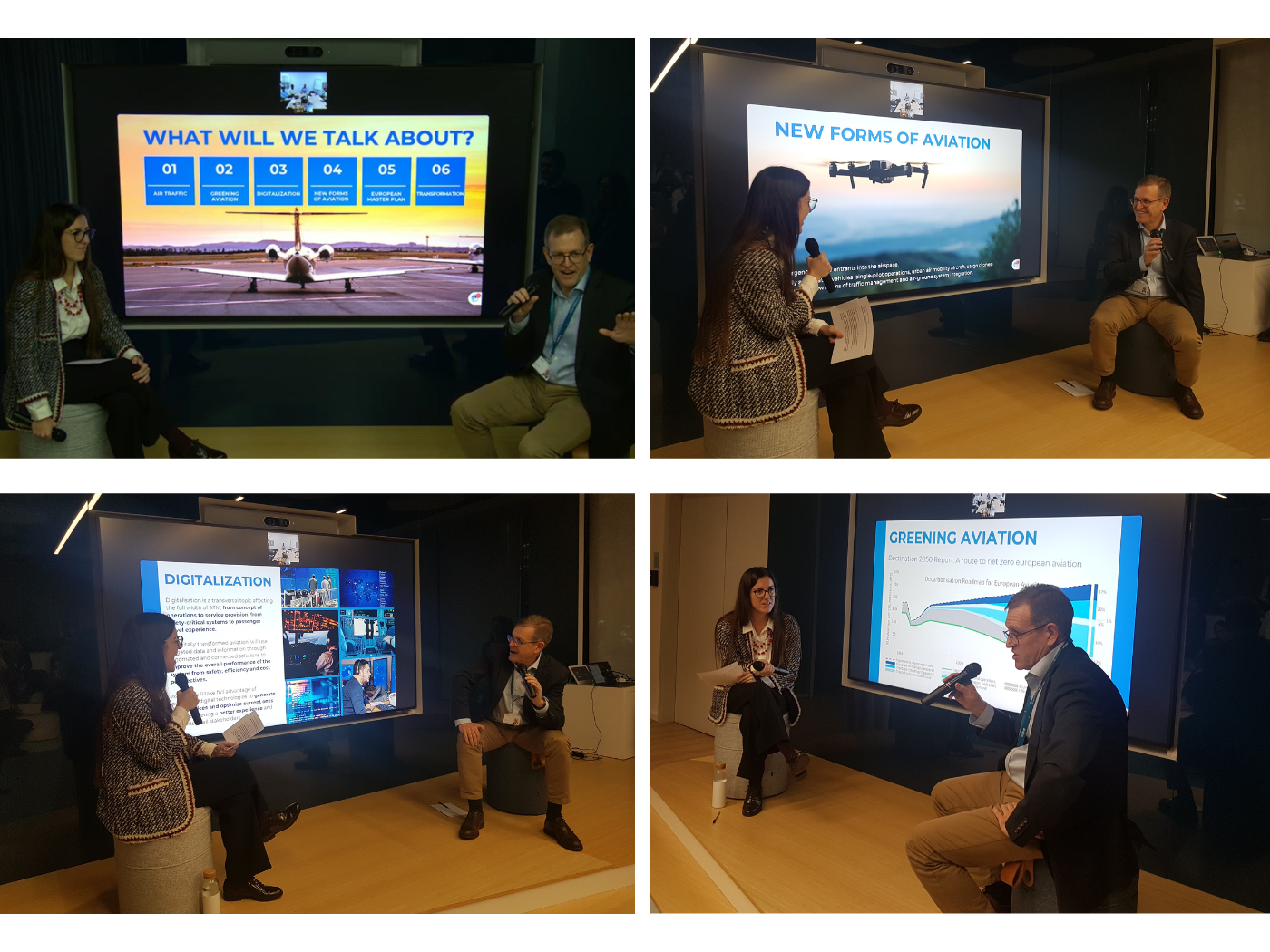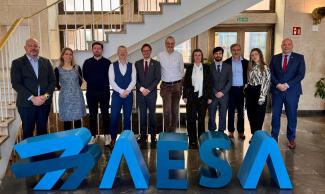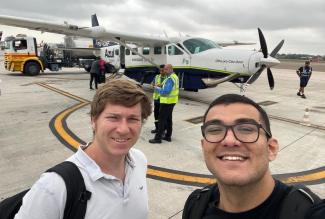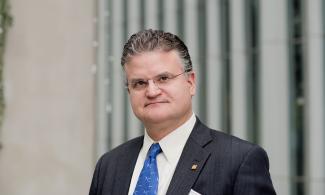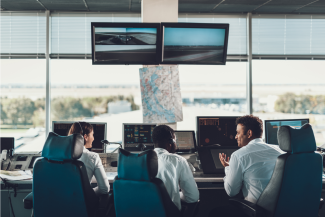¿How is air traffic management evolving to adapt to the changes in aviation, address sector challenges, and leverage the digital revolution? This was the central question we focused on as the backbone of our latest ALG TALK, in which we had a conversation with Ramon Tàrrech, Director of Strategy and Innovation for Air Traffic at Indra and non-executive partner at ALG. With over 30 years of experience working in technical and business aspects of transportation technologies, Ramon shared his insights on air traffic management, addressing key topics such as sustainability, digitization, new aviation forms, the European ATM Master Plan, and the technological evolution shaping the industry.
Defined by ICAO as "the dynamic and integrated management of air traffic and airspace, including air traffic services, airspace management, and air traffic flow management, safely, economically, and efficiently, through the provision of continuous facilities and services in collaboration with all parties and involving functions both in the air and on the ground", ATM (Air Traffic Management) aims to ensure the safe and efficient flow of air traffic. This encompasses three types of services:
- Air Traffic Services (ATS), including air traffic control (ATC), air traffic advice services, flight information services, and alerting services.
- Airspace Management (ASM), which aims to allocate air routes, zones, and flight levels to different users of airspace, as well as the structure of airspace.
- Air Traffic Flow and Capacity Management (ATFCM) or Air Traffic Flow Management (ATFM), involving regulating aircraft flow efficiently to avoid congestion in airspace and airports.
Greening aviation: keys to achieving more sustainable industry
Passenger traffic has experienced a significant increase in the last decade. However, with this growth, the role of aviation and its environmental impact are now subject to increased debate and reflection, especially regarding carbon emissions. If aviation represents around 2-3% of global CO2 emissions (4% in Europe), it is understandable that society expects the sector to fulfill its responsibilities in this regard.
In this context, according to the EU's target, net zero CO2 emissions should be achieved by 2050. The unanimous question is: Can this be possible? Although the fuel efficiency in aircraft operations has improved by an average of over 2% annually between 2009 and 2019, additional actions are needed to reduce the absolute level, even more so if traffic levels continue to rise, as projections suggest.
As discussed with Ramon in our ALG Talk, we believe that decarbonization and eliminating greenhouse gas emissions are desirable and should be achievable, not only for society and the economy as a whole but also for the aviation industry and future generations of travelers. However, we are still far from achieving this.
According to the data collected in the report "Destination 2050: a route to net zero European Aviation" published by SEO Amsterdam Economics (SEO) and Royal Netherlands Aerospace Centre (NLR), net zero CO2 emissions for all flights within and departing from the European Union can be achieved by 2050 through joint, coordinated, and determined efforts by the aviation industry and the public/regulatory sector. The European aviation sector is committed to achieving this goal and contributing to the targets set in the European Green Deal and the Paris Agreement.
Additionally, the Destination 2050 publication presents a possible option to combine new technologies, improved operations, sustainable aviation fuels, and economic measures focused on reducing absolute emissions by 92%, while the remaining 8% would be removed from the atmosphere through negative emissions achieved through natural carbon sinks or specific technologies.
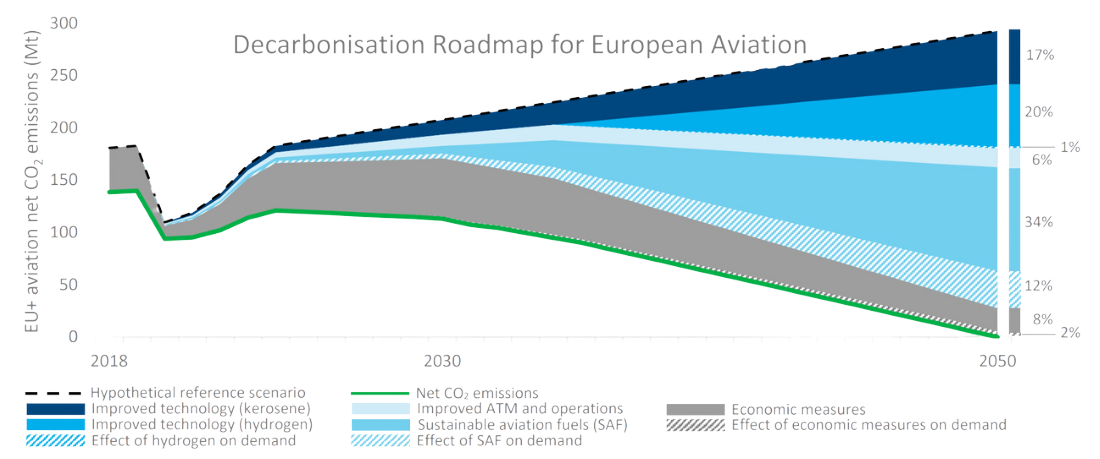
Results are presented for all flights within and departing from the EU region. Improving aircraft and engine technology, ATM and aircraft operations, SAF and economic measures all hold decarbonization potential. Modeled for 2030 and 2050, the impacts are linearly interpolated. The base year for this study is 2018.
Regardless of whether we reach Fly Net Zero by 2050 or not, maintaining a perspective of "green aviation" allows us to drive coordinated activities and programs designed to improve the environmental sustainability of the aviation sector and reduce its direct effects on the environment. This approach includes a variety of tools, technologies, and procedures aimed at reducing greenhouse gas emissions, using less fuel (or sustainable fuel), and promoting environmental responsibility in the aviation industry to make it an industry with less negative impact and more aligned with sustainable development goals.
Digitalization: transforming the way we fly and manage airspace through technology
According to the European ATM Master Plan published in 2020 by Sesar Joint Undertaking, the strategy for digitalization ATM responds to the need to digitize Europe's aviation infrastructure and meet the European Digital Single Market strategy.
To consolidate the ATM industry's position at the forefront of European innovation and achieve a global perspective, digitization becomes relevant and takes center stage, becoming a cross-cutting theme that affects the entire breadth of air traffic, from operational concepts to service provision, critical safety systems to the passenger travel experience.
Now, what direct advantages does digitization bring? According to Ramon's analysis, a "digitally transformed aviation" can use specific data through automated and connected solutions to improve the overall system's performance from safety, efficiency, and cost perspectives. In this way, the aviation sector can harness advanced digital technologies to generate new services, optimize existing ones, and provide a better experience and benefits to all stakeholders.
The opportunities offered by digitization are many, with a clear example being the ability to help reorganize air traffic flows in the event of an incident, and subsequent analysis of alternative actions to choose the best reaction that allows reducing delays and minimizing environmental impact.
To this more digital, sustainable, and efficient aviation undoubtedly contributes to artificial intelligence. According to Ramon's reflection, progress in the field of machine learning is opening doors to new applications in ATM that, far from leaving people on the sidelines of cutting-edge innovation, place them at the center as protagonists of this management. For example, by combining machine learning techniques and human optimization, it is possible to improve the flow of flight plans, allowing for more accurate flight planning and reducing waiting times (holding), as well as contributing to aircraft flying at their optimal levels and reducing unnecessary maneuvers, leading to fuel savings and emission reduction. A virtuous circle for all parties involved.
New forms of aviation and the need for an Unmanned Traffic Management (UTM) system
As already stated in the 2020 European ATM Master Plan, the drone industry has driven new markets and business opportunities, especially in terms of urban mobility and service delivery. However, their arrival has also posed a significant and complex challenge in terms of ATM, given the quantity and heterogeneous nature of these highly automated aerial vehicles (single-pilot operations, urban mobility aircraft, cargo drones, etc.) that require new forms of traffic management and integration of not yet fully established air-to-ground systems.
On the one hand, Unmanned Aerial Systems (UAS) have rekindled interest in the potential to operate vehicles at very high altitudes, with their consequent need for access to and exit from the stratosphere through managed airspace. On the other hand, while there are diverse benefits that these aerial systems can bring to society (from package delivery and infrastructure surveillance to search and rescue, and agricultural monitoring), there is still no infrastructure that allows the safe management of widespread low-altitude airspace use. Therefore, UTM management for low and high-altitude airspace will be an indispensable requirement with the growth of UAS.
The growth of drones in Europe and the consequent need to establish a UAS traffic management system that supports the safe integration of operations has resulted in what is known as U-Space. This concept represents a set of services and procedures based on a high level of digitization and automation of functions to provide, in a regulated and coordinated manner in Europe, safe and efficient access to airspace for a large number of UAS, as well as their coexistence with manned aircraft in certain airspace.
European ATM Master Plan: what could the future look like?
As we concluded the ALG Talk, Ramon emphasized the European ATM Master Plan: a roadmap that links ATM research and development activities with implementation scenarios to achieve the Single European Sky (SES) performance objectives. This initiative aims to achieve more sustainable and efficient aviation in Europe, and the Single European Sky Air Traffic Management (ATM) Research (SESAR) is its technological pillar.
To manage future traffic growth safely and mitigate environmental impact, SESAR's vision is to deliver a fully scalable traffic management system capable of handling the growth of both manned and unmanned air traffic. The current ATM system and network in Europe will only be able to adapt to the expected traffic growth and new challenges if they embrace digitization at an accelerated pace. This effort is fully aligned with the vision of the European Union's aviation strategy, which recognizes SES and SESAR as key drivers of sustainable growth and innovation in air transport. Moreover, SESAR has a significant industrial component for Europe due to the technological and manufacturing aspects of aviation: key dimensions for added value and regional competitiveness.
In conclusion, it is important to emphasize that the enabling dimension of the sector's transformation lies not only in technology but also in business, regulatory, national public administration, EU political, and institutional and global commercial relationship factors. Even more importantly: it is crucial to remember that consultancy and entrepreneurial individuals are at the heart of this transformation. At ALG, we are already working on this and aim to contribute to this significant change.


